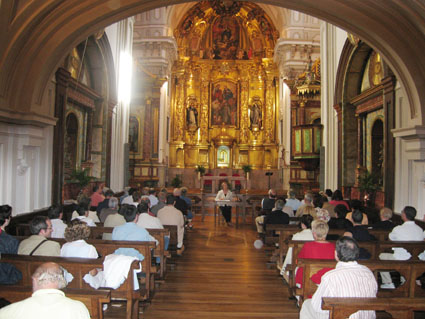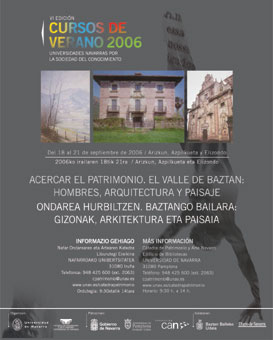BRINGING HERITAGE CLOSER. THE BAZTAN VALLEY: MEN, ARCHITECTURE AND LANDSCAPE
20 September 2006
Juan Bautista Iturralde and his foundations
Dr. Mª Concepción García Gainza. Chair of Navarrese Heritage and Art

The lecture given by Dr. Mª Concepción García Gainza took place in the church of the convent of Santa María de los Ángeles de Arizkun. In it she analyzed the figure of Juan Bautista Iturralde. Born in Arizkun in 1670, Iturralde was one of those baztanes that triumphed in the Madrid of Felipe V, becoming, like his friend and partner Juan de Goyeneche, one of the main financiers of his time. His businesses, centered fundamentally in the military seats, the administration of the rents of the Kingdom of Granada or the real estate investments, allowed him to amass a great fortune, which he adorned with the obtaining in 1739 of the nobiliary degree scroll of Marquis of Murillo, after having occupied the ministry of Finance.
His patrimony was destined in great measure to favor diverse monasteries and religious foundations like the monastery of the Dominicans of Jesus and Maria de Valverde de Fuencarral, where he ordered to be buried in company of his wife, Manuela Munárriz, at the end of his days. But his great foundations were made in Navarra, where he invested, thanks to his deep religiosity, a great part of his fortune. In addition to the high school seminar of San Juan Bautista that he ordered to be built in Pamplona for the people of Baztan, his patronage was centered in his hometown where he promoted and endowed with great wealth the convent of the Poor Clares, completed in 1736.
It is one of the richest and most monumental artistic ensembles erected in Baztan during the 18th century. Its traces, made by the Navarrese Fausto de Manso, arrived from Madrid, giving rise to a convent complex organized around a courtyard, and in which the church stands out, whose facade, with the characteristic reddish stone of Baztán, develops several levels in which the mixtilinear lines and the great bocelones and moldings prevail. The altarpiece is also a good example of the Madrid altarpieces of the period.
The couple Iturralde-Munárriz sent throughout their life a multitude of works of art and liturgical trousseaus to enrich their foundation as well as two full-length portraits, attributed to González Ruiz.

PROGRAM
MONDAY, 18 SEPTEMBER
Place: Elizondo. Arizkunenea Cultural Centre
16.45 h: Opening and presentation of the course
17 h. Juan de Goyeneche, ahead of his time
Prof. Dr. Alfredo Floristán Imízcoz. University of Alcalá de Henares
18 h. Coffee break
18.30 h. Ziga, Lekaroz and Gartzain: the churches of the Renaissance in the Baztan area
Prof. Dr. María Josefa Tarifa Castilla. Chair of Navarrese Heritage and Art
TUESDAY, 19 SEPTEMBER
Place: Elizondo. Arizkunenea Cultural Centre
17 h. From the village to the Court
Prof. Dr. José María Imízcoz Beunza. University of the Basque Country
18 h. Coffee break
18.30 h. Palaces of Baztan
Prof. Dr. Pilar Andueza Unanua. Chair of Navarrese Heritage and Art
Then visit to the Ethnographic Museum of Baztan Jorge Oteiza, guided by Ms. Ana María Marín, member of the Friends of the Museum.
WEDNESDAY, 20TH SEPTEMBER
Place: Arizkun. Convent of the Poor Clares
17 h. Juan Bautista Iturralde and his foundations
Prof. Dr. María Concepción García Gainza. Chair of Navarrese Heritage and Art
Place: Azpilkueta. Parish
18.30h. Families and artistic promotion: Elizacoechea in Azpilkueta, the Jáuregui family in Oharriz
Prof. Dr. Ricardo Fernández Gracia. Chair of Navarrese Heritage and Art
THURSDAY, 21ST SEPTEMBER
Place: Elizondo. Arizkunenea Cultural Centre
17 h. Indian art and architecture in the Baztan Valley. The 19th and 20th centuries
Prof. Dr. Javier Azanza López. Chair of Navarrese Heritage and Art
18 h. Coffee break
18.30 h. Closing session: The Bidasoa School and landscape painting in Baztania.
Prof. Dr. Francisco Javier Zubiaur Carreño. Museum of Navarre
